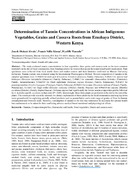| dc.contributor.author | Alwala, Joseck | |
| dc.contributor.author | Kiema, Francis | |
| dc.contributor.author | Wanzala, Wycliffe | |
| dc.date.accessioned | 2021-11-02T09:35:07Z | |
| dc.date.available | 2021-11-02T09:35:07Z | |
| dc.date.issued | 2014-01-15 | |
| dc.identifier.uri | http://erepository.kibu.ac.ke/handle/123456789/3255 | |
| dc.description.abstract | The study evaluated tannin concentrations in four vegetables, three grains and cassava roots as the most common
foodstuffs in the diet of local communities from Emuhaya district in western Kenya and their nutritional health implication. Plant
specimens were collected from local arable farms and market centres and their identities confirmed at Maseno University
herbarium. Tannin content was evaluated using the International Phamacopoeia Method. Percent composition of tannins in the
sampled specimens were: 9.49±0.6 for rattle pod (Crotalaria brevidens (Emiroo); Family, Fabaceae), 8.38±0.3 for narrow-leaf
bitter-pea (Daviesia leptophylla (Omurere); Family, Fabaceae), 2.49±0.2 for amaranth (Amaranthus hybridus (Tsimboka);
Family, Amaranthaceae), 0.42±0.04 for black nightshade (Solanum nigrum (Lisutsa); Family, Solanaceae), 9.21±0.4 for
peanut/groundnut (Arachis hypogaea (Tsinjugu); Family, Fabaceae), 8.24±0.4 for sesame (Sesamum indicum (Tsinuni); Family,
Pedaliaceae), 8.11±0.2 for finger millet (Eleusine coracana (Obulee); Family, Poaceae) and 6.99±0.5 for cassava (Manihot
esculenta (Emioko); Family, Euphorbiaceae). Solanum nigrum had significantly the lowest tannin composition profile followed
by A. hybridus and M. esculenta in that order (P < 0.05). Interestingly, these three plants are preferred in the diet to the rest of the
plants. The results provide scientific rationale for dietary exploitation of these plants by the local communities and may lay down
some groundwork for exploiting partially refined products such as peanut butter and a wide range of grades of flour for human
consumption and livestock feeds. However, consumption of tannins in the diet may sometimes be necessary for optimal health
but caution needs to be taken for their conflicting adverse medical-based nutritional and physiological effects | en_US |
| dc.language.iso | en | en_US |
| dc.publisher | American Journal of Nutrition and Food Science | en_US |
| dc.rights | Attribution-NonCommercial-ShareAlike 3.0 United States | * |
| dc.rights.uri | http://creativecommons.org/licenses/by-nc-sa/3.0/us/ | * |
| dc.subject | Tannins, Composition profiles, Human diet and health, Food vegetables, Grains and cassava roots | en_US |
| dc.title | Determination of Tannin Concentrations in African Indigenous Vegetables, Grains and Cassava Roots from Emuhaya District, Western Kenya | en_US |
| dc.type | Article | en_US |

